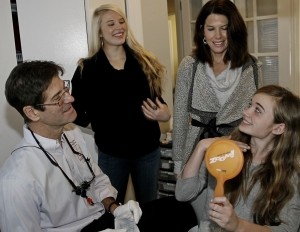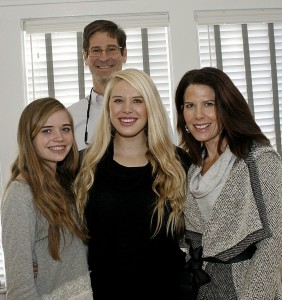 |
| Sadie, in the dental chair, wins approval from Dr. Andreaus for maintaining her Invisalign protocol, as Sister Drake and Mom Hunter express their pleasure. |
“It didn’t work out that way, but we have had the great good fortune to work with Dr. Steven Andreaus and as a result, our daughters, Drake and Sadie, have overcome serious dental issues and spend a lot of their time smiling in a really lovely way. They could, I think, be Poster Children for Invisalign—and Dr. Andreaus is a master of the Invisalign process.” (see box, below)
In fact, Dr. Andreaus is nationally recognized for his expertise in cosmetic and aesthetic dentistry, and is one of about 500 dentists who have earned accreditation by the American Academy of cosmetic Dentists. He now serves on the governing board of that international association.
 |
| The happy Buxton family with Dr. Andreaus, Sadie, Drake and their mother, Hunter. |
The Invisalign Look
Drake, now a busy, involved freshman at UNC-Chapel Hill, first came to Dr. Andreaus three years ago, badly in need of expert dental care. She had two upper teeth, the canine teeth, that were much higher than all of her other upper teeth—“kind of a snag tooth look,” her mother commented. The need for braces was clear. “But fortunately I found out about Dr. Andreaus and Invisalign, and after two years of treatment, Drake’s teeth were perfectly aligned and looked wonderful.”
The patient, living an involved and complicated life at Carolina, is happy with the outcome. “I faithfully wear my retainers at night,” she says, “and it’s really pretty easy. Dr. Andreaus gave me an A+ for my dental hygiene, and I’ve been very satisfied overall. It’s not a time-consuming task.”
About Invisalign
Dr. Andreaus gained recognition as a top provider of Invisalign precisely because it is an invaluable tool in protecting a patient’s natural teeth even as it works, over time, to give them a wonderful smile.
“Invisalign is an excellent choice for about 80 percent of the people who could benefit from orthodontic work,” notes Dr. Andreaus. “Using orthodontic braces, it’s possible to move a tooth as much as a quarter of a millimeter every two weeks. Of course, that adjustment has to be done by the orthodontist. Invisalign, quite differently, is actually programmed by computer to make exact incremental movements of a quarter of a millimeter every two weeks.
“For some patients, as a result of Invisalign, we don’t need to restore a tooth. Invisalign allows me to take care of their wishes in an aesthetic fashion even as we’re also straightening their teeth orthodontically.”
Invisalign received FDA approval in 1998. “Invisalign utilizes advances in 3-D imaging technology to create a series of customized plastic aligners,” Dr. Andreaus explains. “Patients simply wear each aligner for a few weeks, removing it only to eat, brush, and floss. After as few as 8 or as many as 48+ nearly invisible aligners, the procedure is done. And the results are consistently wonderful. Patients typically finish the process in 6 to 18 months.
“Invisalign is a creative mix of physics and physiology. It’s largely about applying exactly the right amount of pressure in the right place in the proper sequence. It is a highly effective but complicated process: experience really does matter. It has become more sophisticated and far more effective in the past decade, but it has to be done in the proper sequence considering the needs of every tooth involved in the process.”
In fact, Dr. Andreaus has used Invisalign successfully with patients in virtually all stages of life, from pre-teens to senior citizens. The Invisalign process “utilizes advances in 3-D imaging technology to create a series of customized plastic aligners,” he explains. “Patients like Drake simply wear each aligner for a few weeks, removing it only to eat, brush, and floss. After use of as few as 8 or as many as 48+ nearly invisible aligners, the procedure is done. And the results are consistently wonderful. Patients typically finish the process in 6 to 18 months.”
Complications
Drake’s sister, Sadie, is a 13-year-old eighth grader with dental issues somewhat more complicated than her sister’s. In fact, Dr. Andreaus says, “We’re doing some very special work for Sadie. She had some crowding and spacing issues, and she had three baby teeth remaining. We could see that the cuspids were going to come out like fangs, and very high, just as was true for her sister.
“We humans develop four cuspids, one in each dental quadrant, sometime between the ages of 11 and 12. They’re important, because they help guide the teeth and jaws into their proper biting position.
“And so I talked with Sadie’s Mom and to Sadie, and suggested that we remove these three baby teeth to greatly facilitate the Invisalign process, and Sadie replied, ‘Let’s do it now!’ She is very much like her sister: an incredible soccer player, and a great student.
“So that is exactly how we proceeded. We removed those three misaligned baby teeth, and two weeks later we placed Sadie’s first Invisalign aligners. And I actually placed false teeth in the aligner trays so it looks exactly as if Sadie has all of her teeth—which addressed her number one concern.
“You know that if you’re in eighth grade and you have to walk around with a half smile because of missing teeth, it’s not a good day,” comments Dr. Andreaus. “We normally have our Invisalign patients come back every three to four aligners, which is every six to eight weeks. But Sadie is returning every two weeks so that every time she gets a new aligner we remake the false teeth and make sure they are not impeding the permanent teeth that are in the process of erupting. If we made these aligners further in advance, they might look fine but it would be difficult to make them fit properly. It’s like buying shoes for your eight-year-old that they will wear when they turn 12. You actually have no idea what the size needs to be. So every two weeks we remake these false teeth and adjust them so that they will fit and allow the permanent teeth to continue to properly fall into place. At the moment, Sadie is about half way through this process.”
